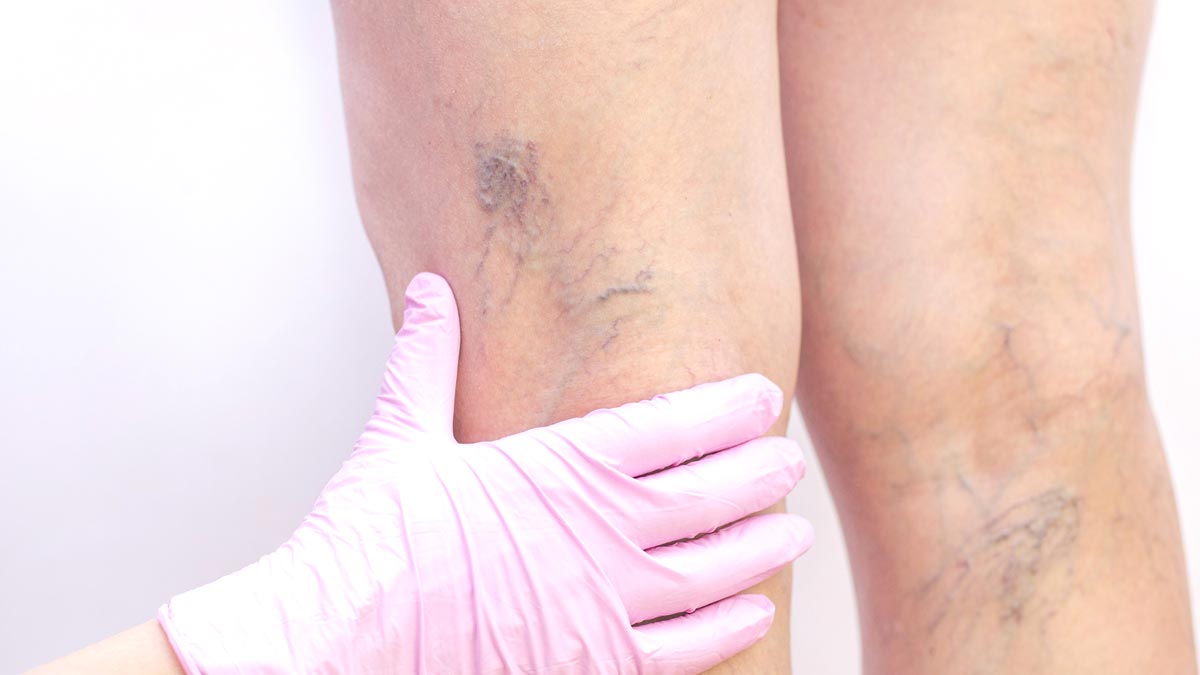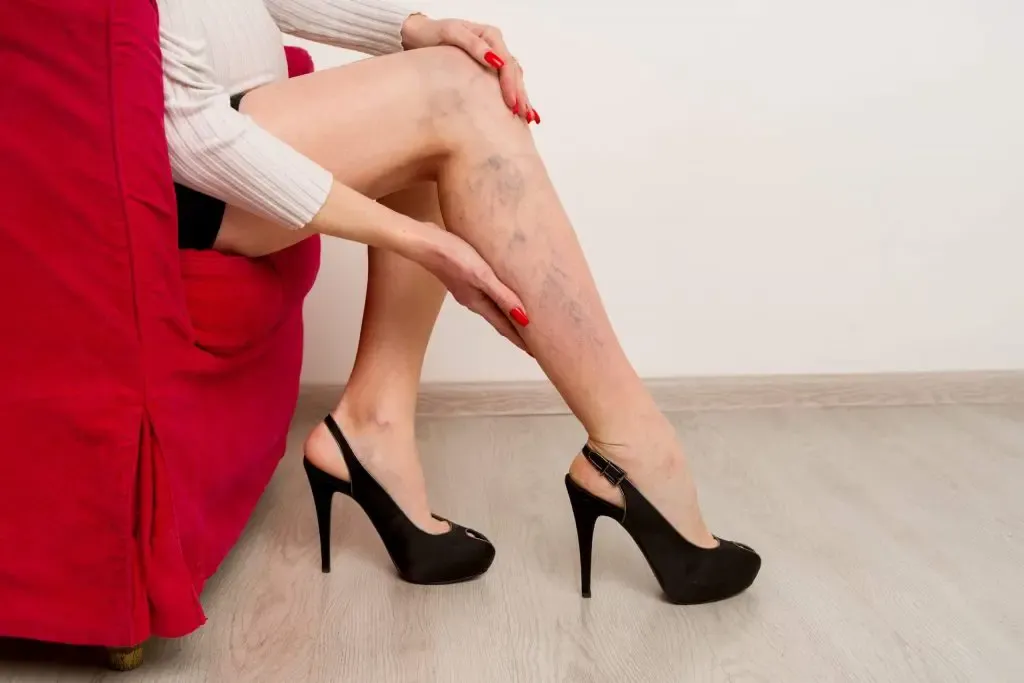Chronic Venous Insufficiency
Causes of Chronic Venous Disease
Treatment of Chronic Venous Disease
Signs & Symptoms of Chronic Venous Disease
Prevention of Chronic Venous Disease
9/13/2023
Your Guide to Chronic Venous Disease: 12 Common Questions Answered
If you have heavy painful legs, varicose veins and other symptoms of poor leg vein health, you might be suffering from chronic venous insufficiency (CVI). Although the disease can be more common in women than in men, with a prevalence ranging between 25%–40% and 10%–20%, respectively,1 it is a progressive disease that can affect anyone, and can degenerate quickly unless swift action is taken, such as lifestyle changes and the potential use of venoactive drugs.
Here, we’ve answered some of the most commonly asked questions about chronic venous disease.

What is Chronic Venous Disease / Insufficiency?
Chronic venous insufficiency also known as CVI is a common disease caused by the weakening or the malfunctioning of the valves in the leg veins which decrease the blood flow from the legs to the heart. CVI usually affects the lower limbs and can impact on quality of life.1
Can chronic venous disease / insufficiency be cured?
Chronic venous insufficiency is a long-term condition that has no cure.2 Because it is mainly caused by incompetent valves in the veins, CVI can be improved with lifestyle changes and controlled with the use of medications such as venoactive drugs which effectively target the source of the problem.
What is the most common cause of chronic venous disease / insufficiency?
Suffering from a deep vein thrombosis (DVT) is typically the most common cause of chronic insufficiency as blood clots can damage the valves that are present in the veins of your legs.
Aside from DVT, other possible factors can also cause chronic venous insufficiency such as congenital factors that might have provoked malformation in the veins of your legs, lifestyle factors (such as smoking, high blood pressure due to standing or sitting for long periods of time, or obesity among other causes), hereditary factors, surgery, or pregnancy.3
You can read more about how to help with painful heavy legs during the working day.

What are the signs and symptoms of chronic venous disease / insufficiency?
The most common signs and symptoms of CVI include:
- Edema or the swelling of the legs or ankles
- Pain that gets worse when you stand and gets better when you raise your legs
- Heavy and painful legs
- Itchy legs
- Leg ulcers or skin that changes color around the ankles
- Varicose veins
- Tightness in your calves4
What can happen if chronic venous disease/ insufficiency is untreated?
Chronic venous insufficiency is a progressive disease, as such, if left untreated it may lead to serious health complications that include persistent pain, hemorrhage, superficial thrombophlebitis or blood clots, and progressive skin changes that can cause ulceration.5 That is why we would highly recommend you to consult your doctor and ask them about the use of venoactive drugs.
Is walking good for venous disease / insufficiency?
Walking is considered one of the best exercises for chronic venous insufficiency. According to researchers, walking helps increase the movement of the ankle joint, which has a positive impact on the strengthening of the calf muscle pump which limits the disease’s progression and its consequences.6

Can I take airplanes with venous disease?
It is always recommended to consult your doctor for specific recommendations for your individual case; however, in general terms, people who suffer from chronic venous insufficiency can take airplanes, provided they take the necessary steps to avoid prolonged periods of sitting which would increase the risk of a blood clot.7
For more information and tips, explore our article on long-distance traveling with venous insufficiency.
What is the best diet for chronic venous disease?
When it comes to preventing the worsening of chronic venous disease, a healthy diet can become a great companion to strengthen the health of the body and veins. Generally speaking, it is recommended to avoid as much as possible the use of salt, limit the consumption of processed food, and opt for organic fresh fruit and vegetables. If you want to learn more about the specific foods that can help improve vein health, check out our article about what to eat and drink to improve blood circulation.
Are swollen legs at work a symptom of chronic venous disease?
Swollen legs, also referred to as edema of the lower limbs,8 can happen for various reasons. However, if you spend long periods of time in the same position at work, and you feel that your legs are continually swollen at the end of the working day, you might be suffering from chronic venous disease and it is recommended to visit a vascular specialist for evaluation. Check out more on how to help with painful and heavy legs during the working day.

How can chronic venous disease / insufficiency be treated?
There are different areas that can be taken into account to treat chronic venous insufficiency: lifestyle changes, medications, and medical procedures.
Lifestyles changes include diet, exercise, and weight loss if applicable. Learn more about lifestyle changes to combat chronic venous disease.
Medications include the oral administration of venoactive drugs that can improve the feeling of heaviness within the legs of patients suffering from varicose veins and chronic venous disease. As opposed to creams, that act to only alleviate potential discomfort, venoactive drugs can help improve blood flow in the lower legs.9
Finally, other possible medical procedures include radiofrequency ablation or sclerotherapy.10
Are varicose veins a symptom of venous disease / insufficiency?
Yes, they can be. Although the terms varicose veins and chronic venous insufficiency (CVI) can sometimes be used interchangeably, it is important to note that CVI refers to the range of vascular disorders that cause venous disease and can affect deep veins, whilst varicose veins refer to dilated superficial veins that become progressively more tortuous and enlarged.11
Can you feel venous disease / insufficiency?
Although symptoms of venous insufficiency tend to increase with time, such as painful and heavy legs, or swollen and itchy legs, these symptoms can also mimic other diseases such as osteoarthritis, sciatica, or arterial insufficiency12 (check out more about the differences between deep vein thrombosis and venous disease). Therefore, it is always important to consult a doctor in case of any doubt. If your legs often feel sore and heavy, you might be experiencing the first warning signs of Chronic Venous Insufficiency. We encourage you to take this self-assesment test to help guide you through the next steps to prevent further venous disease.
REFERENCES
- Al Shammeri O, AlHamdan N, Al-Hothaly B, Midhet F, Hussain M, Al-Mohaimeed A. Chronic Venous Insufficiency: prevalence and effect of compression stockings. Int J Health Sci (Qassim). 2014 Jul;8(3):231-6, from https://www.ncbi.nlm.nih.gov/pmc/articles/PMC4257358/
- Ortega MA, Fraile-Martínez O, García-Montero C, Álvarez-Mon MA, Chaowen C, Ruiz-Grande F, Pekarek L, Monserrat J, Asúnsolo A, García-Honduvilla N, Álvarez-Mon M, Bujan J. Understanding Chronic Venous Disease: A Critical Overview of Its Pathophysiology and Medical Management. J Clin Med. 2021 Jul 22;10(15):3239, from https://www.ncbi.nlm.nih.gov/pmc/articles/PMC8348673/
- Shivik K. Patel; Scott M. Surowiec. (2021) Venous Insufficiency. Upstate Medical University. https://www.ncbi.nlm.nih.gov/books/NBK430975/
- Eberhardt, R. T.; Raffetto, J. D. (2014). Chronic Venous Insufficiency. Circulation, 130(4), 333–346. doi:10.1161/CIRCULATIONAHA.113.006898
- Eberhardt, R. T.; Raffetto, J. D. (2014). Chronic Venous Insufficiency. Circulation, 130(4), 333–346. doi:10.1161/CIRCULATIONAHA.113.006898
- Araujo DN, Ribeiro CT, Maciel AC, Bruno SS, Fregonezi GA, Dias FA. Physical exercise for the treatment of non-ulcerated chronic venous insufficiency. Cochrane Database Syst Rev. 2016 Dec 3;12(12):CD010637, from https://www.ncbi.nlm.nih.gov/pmc/articles/PMC6463841/
- Abramowitz HB, Gertz SD. Venous stasis, deep venous thrombosis and airline flight: can the seat be fixed? Ann Vasc Surg. 2007 May;21(3):267-71, from https://pubmed.ncbi.nlm.nih.gov/17484958/
- Gasparis AP, Kim PS, Dean SM, Khilnani NM, Labropoulos N. Diagnostic approach to lower limb edema. Phlebology. 2020 Oct;35(9):650-655, from https://www.ncbi.nlm.nih.gov/pmc/articles/PMC7536506/
- Prof. José N. Boada, Gloria J. Nazco (1999). Therapeutic Effect of Venotonics in Chronic Venous Insufficiency. , 18(6), 413–432, from https://link.springer.com/article/10.2165/00044011-199918060-00001
- de-Abreu, Guilherme Camargo Gonçalves; Camargo Júnior, Otacílio de; de-Abreu, Márcia Fayad Marcondes; de-Aquino, José Luís Braga (2017). Ultrasound-guided foam sclerotherapy for severe chronic venous insufficiency. Revista do Colégio Brasileiro de Cirurgiões, 44(5), 511–520, from https://pubmed.ncbi.nlm.nih.gov/29019582/
- Youn YJ, Lee J. Chronic venous insufficiency and varicose veins of the lower extremities. Korean J Intern Med. 2019 Mar;34(2):269-283, from https://www.ncbi.nlm.nih.gov/pmc/articles/PMC6406103/
- Krishnan S, Nicholls SC. Chronic venous insufficiency: clinical assessment and patient selection. Semin Intervent Radiol. 2005 Sep;22(3):169-77, from https://www.ncbi.nlm.nih.gov/pmc/articles/PMC3036279/
2026